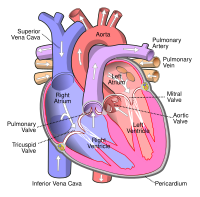
Photo from wikipedia
Purpose Ventricular assist device (VAD) for systemic right ventricular failure (SRVF) post atrial switch for transposition of the great arteries (TGA) and congenitally corrected TGA (ccTGA) has proven useful to… Click to show full abstract
Purpose Ventricular assist device (VAD) for systemic right ventricular failure (SRVF) post atrial switch for transposition of the great arteries (TGA) and congenitally corrected TGA (ccTGA) has proven useful to reduce transpulmonary gradient (TPG) and bridge-to-transplantation. The hemodynamic impact of severe tricuspid regurgitation (TR), potential role of systemic tricuspid valve replacement (TVR) and long-term outcomes are still unknown. The purpose of this study is to describe our experience of VAD in SRVF and our move towards concomitant TVR. Methods Single-centre retrospective study of consecutive adult patients receiving HeartWare-VAD for SRVF between 2010 and 2020. From 2017, concomitant TVR was performed routinely. Demographic, clinical variables and echocardiographic and haemodynamic measurements pre and post VAD implantation were recorded. Complications on support, heart transplantation and survival rates were described. Results 24 patients underwent VAD implantation. Moderate or severe systemic TR was present in 83% of patients, and subpulmonic left ventricular (LV) impairment in 79%. One and two-year survival rates were 75% and 60% respectively. VAD implantation was technically feasible and successful in all but one. Post VAD, TPG fell from 16 (15-20) to 10 (7-13) mmHg; p=0.002. Patients with TVR (n=12) also demonstrated reduction in pulmonary and atrial pressures (figure). Subpulmonic LV end-diastolic dimension (50 vs 42mm; p=0.05) and systolic function improved in this group. On the other hand a high prevalence of subpulmonic LV failure was noted in the non TVR group (50% vs 8.3%; p=0.03) resulting in higher mortality. After six months on support, 63% of patients were suitable for transplantation. Conclusion VAD implantation for patients with SRVF in TGA or ccTGA is feasible, and significantly reduces the TPG to transplantable limits. Concomitant TVR at the time of implant associates better haemodynamic and echocardiographic results.
Journal Title: Journal of Heart and Lung Transplantation
Year Published: 2021
Link to full text (if available)
Share on Social Media: Sign Up to like & get
recommendations!